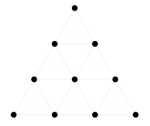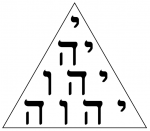Tetraktys
Tetraktys (τετρακτύς) is a Greek word meaning "tetrad". It refers to a triangular figure consisting of ten points arranged in four levels with one, two, three, and four points in each row. This was an important mystical symbol used by the Pythagoreans.
In Theosophy
“The Pythagorean world,” Plutarch tells us (in De anim. procr., 1027) “consisted of a double quaternary.” This statement corroborates what is said about the choice, by the exoteric theologies, of the lower Tetraktis. For:—“The quaternary of the intellectual world (the world of Mahat) is T’Agathon, Nous, Psyche, Hyle; while that of the sensible world (of matter), which is properly what Pythagoras meant by the word Kosmos—is Fire, Air, Water, and Earth. The four elements are called by the name of rizomata, the roots or principles of all mixed bodies,” i.e., the lower Tetraktis is the root of illusion of the world of matter; and this is the tetragrammaton of the Jews, and the “mysterious deity,” over which the modern Kabalists make such a fuss!
In Kabbalah
There is an arrangement of the letters of the Tetragrammaton (the four lettered name of God in Hebrew scripture יהוה or YHWH), where they are inscribed on the ten positions of the tetraktys, from right to left.
In this regard, Mme. Blavatsky said:
The Tetrad is esteemed in the Kabala, as it was by Pythagoras, the most perfect, or rather sacred number, because it emanated from the one, the first manifested Unit, or rather the three in one. Yet the latter has been ever impersonal, sexless, incomprehensible, though within the possibility of the higher mental perceptions.[1]
Notes
- ↑ Helena Petrovna Blavatsky, The Secret Doctrine vol. II, (Wheaton, IL: Theosophical Publishing House, 1993), 599.

